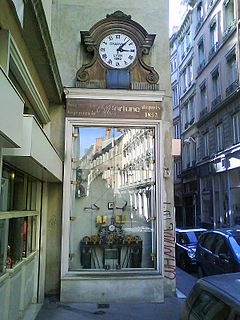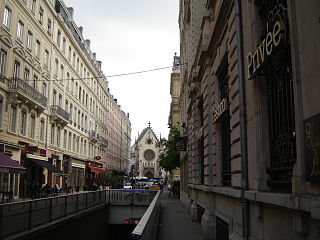Related Research Articles

Saint Fiacre is the name of three different Irish saints, the most famous of which is Saint Fiacre of Breuil, the Catholic priest, abbot, hermit, and gardener of the seventh century who was famous for his sanctity and skill in curing infirmities. He emigrated from his native Ireland to France, where he constructed for himself a hermitage together with a vegetable and herb garden, oratory, and hospice for travellers. He is the patron saint of gardeners.

The Rue du Faubourg Saint-Honoré is a street located in the 8th arrondissement of Paris, France. Relatively narrow and nondescript, especially in comparison to the nearby Avenue des Champs-Élysées, it is cited as being one of the most luxurious and fashionable streets in the world thanks to the presence of virtually every major global fashion house, the Élysée Palace, the Hôtel de Pontalba, the Embassy of Canada, the Embassy of the United Kingdom, as well as numerous art galleries.

Paris is the centre of a national, and with air travel, international, complex transport system. The modern system has been superimposed on a complex map of streets and wide boulevards that were set in their current routes in the 19th century. On a national level, it is the centre of a web of road and railway, and at a more local level, it is covered with a dense mesh of bus, tram and metro service networks.

Jean-Baptiste Alexandre Le Blond was a French architect and garden designer who became the chief architect of Saint Petersburg in 1716.

The rue Saint-Honoré is a street in the 1st arrondissement of Paris, France.

Le Meurice is a Brunei-owned five-star luxury hotel in the 1st arrondissement of Paris opposite the Tuileries Garden, between Place de la Concorde and the Musée du Louvre on the Rue de Rivoli. From the Rue de Rivoli, it stretches to the Rue du Mont Thabor. The hotel was opened in 1815. It received the "Palace" distinction from the French government in 2011. Le Meurice is owned and operated by the Dorchester Collection, a luxury hotel operator based in London. The hotel has a staff of over 400 and houses 160 rooms decorated in the Louis XVI style, which start at US$1,235 per night.

Henri Sauvage was a French architect and designer in the early 20th century. He was one of the most important architects in the French Art nouveau movement, Art Deco, and the beginning of architectural modernism. He was also a pioneer in the construction of public housing buildings in Paris. His major works include the art nouveau Villa Majorelle in Nancy, France and the art-deco building of the La Samaritaine department store in Paris.

The Rue de la Poulaillerie is a street located in the 2nd arrondissement of Lyon, France. It was first named rue Vaudran, and also rue Maudite in reference to Peter Waldo, who founded what was considered a heresy at the time, the street received its current name from the fact that people exchanged poultry until 1835, when part of this trade emigrated to the covered market of La Martinière.

The Rue de la Bourse is a street located mainly in the 2nd arrondissement of Lyon, and also in the 1st arrondissement. It starts on the Place des Cordeliers, in the 2nd arrondissement, in front of the Église Saint-Bonaventure, and ends at right angles to the Rue du Bât-d'Argent, beyond which it is extended by the Rue du Garet.

The Rue du Bât-d'Argent is an old street which crosses perpendicularly a part of the Presqu'île quarter in the 1st arrondissement of Lyon. It begins at the rue Édouard-Herriot, in continuation of the rue du Plâtre, crosses the rue de la République and the rue du Garet, and ends on the Quai Jean Moulin. The street is famous for its college, the Collège-lycée Ampère.

The Rue Lanterne is one of the oldest streets of Lyon, created in the Middle Ages, which is located in the 1st arrondissement of Lyon. It begins after the rue d'Algérie and ends against a facade of the rue Longue.

The rue Sainte-Catherine is a very old street at the foot of the slopes of La Croix-Rousse quarter, in the 1st arrondissement of Lyon. It is particularly known for being a drinking street. The street belongs to the zone classified as World Heritage Site by UNESCO.

The Rue de l'Arbre-Sec is an old street located in the 1st arrondissement of Lyon, near the Place des Terreaux and the Opera Nouvel. It starts perpendicular to the rue Édouard-Herriot and ends with the Quai Jean Moulin crossing the rue de la République. The name dates from the 14th century and was probably chosen because of a dry tree that could be seen in this street and of an inn sign.

The Rue Lainerie is an ancient cobbled pedestrian street of the Vieux Lyon quarter, in the 5th arrondissement of Lyon. From north to south, it connects two quarters, Saint-Paul and Saint-Jean, and more precisely the Place du Change and the Place Saint-Paul. There is currently an academy of music at No. 1 and many hotels. The street is served by many buses (29-30-31-44-184), two metro stations and a velo'v station. It belongs to the zone classified as World Heritage Site by UNESCO.

The Rue du Bœuf is a 188-metre cobbled pedestrian street of the Vieux Lyon quarter, located in the 5th arrondissement of Lyon. Very representative of the Renaissance architecture of the neighborhood, it is lined only with old houses from the 16th or 17th century. The street connects the rue de Gadagne which it continues after the Place du Petit Collège and the intersection of the rue du Chemin Neuf, the rue de la Bombarde and the rue Tramassac which prolongs it. The street belongs to the zone classified as World Heritage Site by UNESCO.

The Rue du Sergent Blandan is one of the oldest streets of Lyon. It connects Saint Vincent and the slopes of the Croix-Rousse quarters, in the 1st arrondissement of Lyon. The street starts rue Pareille, runs along the Place Sathonay, crosses the rue Hippolyte Flandrin, the rue Louis Vitet and the rue du Terme, and becomes the rue des Capucins just after the square of the same name. The street belongs to the zone classified World Heritage Site by UNESCO. It is named in honour of Sergent Blandan, who participated in the conquest of Algeria.

A fiacre is a form of hackney coach, a horse-drawn four-wheeled carriage for hire. In Vienna such cabs are called Fiaker.

Hotel La Lousiane is a Parisian hotel located at the heart of Saint-Germain-des-Prés at the intersection of rue de Buci and rue de Seine in the sixth arrondissement. It has a main entrance on 60, rue de Seine and a side entrance on 27 rue de Buci. It sits at the crossroad between four central lines: the Passarella des Arts (N), the Luxembourg Garden, (S), rue St Guillaume, (W) and place St Michel, (S). It is most associated with jazz musicians of the 1950s and 1960s. Oscar Peterson, Miles Davis, Bud Powell, Max Roach, Dizzy Gillespie, Art Blakey, Billie Holiday, Lester Young and Charlie Parker all stayed at the hotel. In the early 1960s, Powell and his wife Buttercup resided at the hotel for a long period.

The carrosses à cinq sols (English: five-sol coaches) were the first modern form of public transport in the world, developed by mathematician and philosopher Blaise Pascal.

Rue de Valois is a street in the Palais-Royal quarter in the 1st arrondissement of Paris, France.
References
- ↑ Campbell, Gordon (28 March 2013). The Hermit in the Garden: From Imperial Rome to Ornamental Gnome. Oxford University Press. p. 168. ISBN 978-0-19-164449-8.
- ↑ "St. Fiacre". Catholic Encyclopedia. Retrieved 11 July 2014.; the narrow alley, ruelle de St-Fiacre, opening off rue St-Martin in the 6th Arrondissement, survived into the 19th century: see Dictionnaire topographique, étymologique et historique des rues de Paris, 1812: "FIACRE (cul-de-sac Saint-).
- ↑ Henri Sauval, Histoire et Recherches sur les Antiquités de la ville de Paris, 1724,noted in The Dublin University Magazine: A Literary and Political Journal, 69 1867:595.
- ↑ Anderson, John P. (1 July 2009). Joyce's Finnegans Wake: The Curse of Kabbalah. Universal-Publishers. p. 226. ISBN 978-1-59942-901-4.
- ↑ Louis Jean Nicolas de Monmerque, Les Carrosses à cinq sols, ou les Omnibus du xv11e s1ècle. (Paris: Didot) 1828.